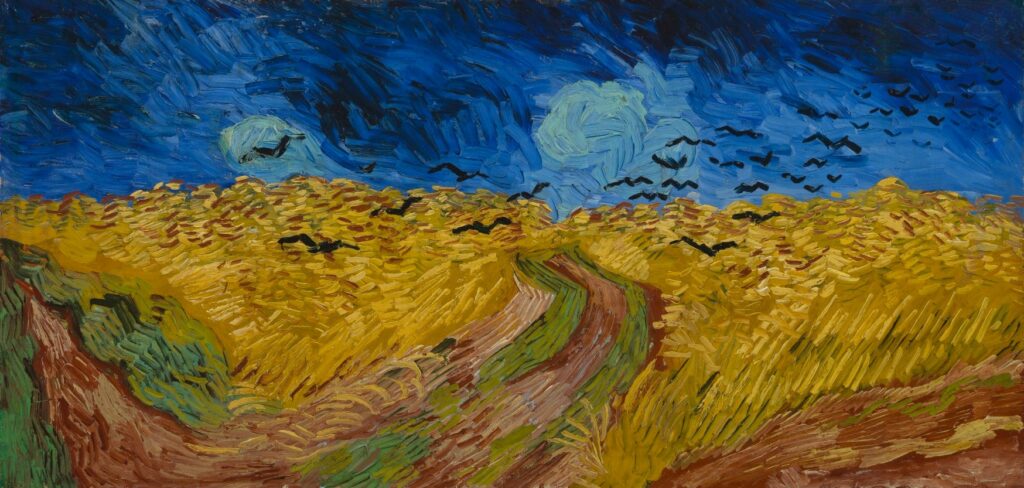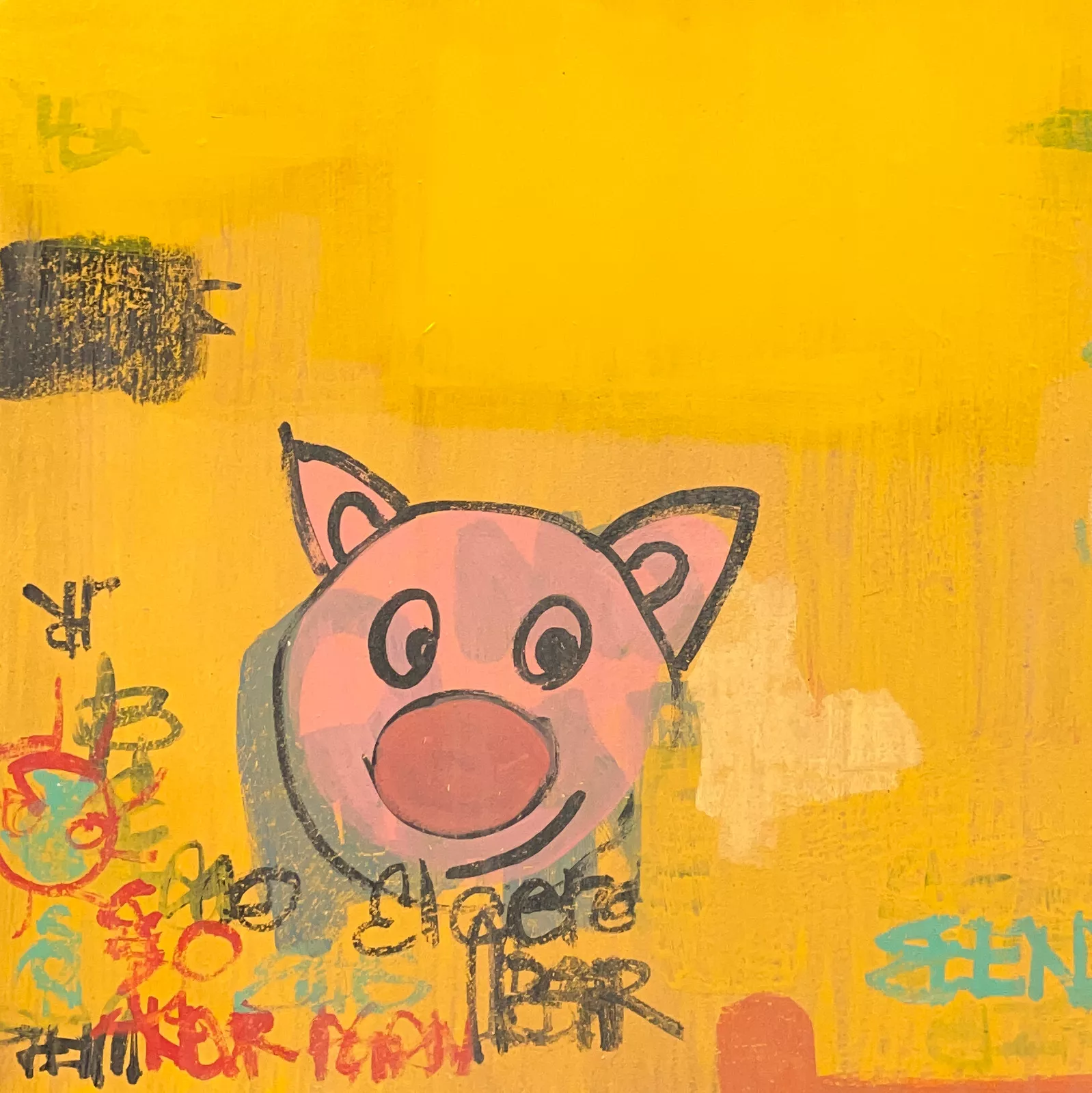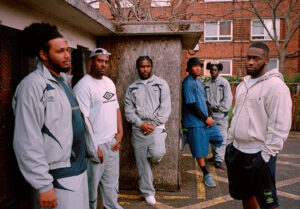Vincent van Gogh’s Wheatfield with Crows (1890) is one of the most celebrated works in the artist’s oeuvre, not only for its striking composition and vibrant colors but also for the deep emotional resonance it carries. Painted during the final weeks of his life, this piece is often interpreted as an artistic expression of his inner turmoil and a farewell to the world. Now housed in the Van Gogh Museum in Amsterdam, Wheatfield with Crows is a captivating testament to Van Gogh’s genius and his unique ability to translate raw emotion into visual form.
Context of Creation
Vincent van Gogh painted Wheatfield with Crows in July 1890, during his stay in Auvers-sur-Oise, a small village near Paris. This period marked the final chapter of his life, following his release from the asylum at Saint-Rémy-de-Provence. Van Gogh had sought refuge in the pastoral landscapes of Auvers, finding solace and inspiration in its fields and skies. However, his mental health remained fragile, and the weight of his struggles is palpable in the artworks he produced during this time.
Wheatfield with Crows was part of a series of paintings depicting wheat fields around Auvers. These works reflect Van Gogh’s fascination with the cycles of nature—growth, harvest, and renewal—but also hint at his personal sense of isolation and existential questioning. The painting’s powerful composition and emotive use of color suggest a complex interplay between beauty, chaos, and despair.
The Composition
The painting’s composition is dominated by a vast wheat field, divided into three paths that lead the viewer’s eye into the scene. The central path appears to disappear into the horizon, flanked by two diverging paths that fade into uncertainty. This creates a sense of disorientation and ambiguity, as if the paths lead nowhere, reinforcing the themes of uncertainty and existential dread.
Above the wheat field looms a dark, turbulent sky, filled with ominous black crows in mid-flight. The contrast between the golden field and the stormy sky creates a dramatic tension, pulling the viewer into the emotional intensity of the scene.
The painting’s perspective is unconventional and unsettling. The horizon line is high, compressing the space and giving the viewer a sense of being enveloped by the landscape. This immersive quality enhances the painting’s emotional impact, making it feel like a personal, almost claustrophobic, experience.
Color Palette
Van Gogh’s use of color in Wheatfield with Crows is bold and evocative. The golden yellows of the wheat field are vibrant and full of life, while the deep blues and blacks of the sky create a stark contrast, evoking a sense of foreboding. The crows, painted in stark black, add an element of menace and unpredictability to the scene.
This dynamic interplay of warm and cool tones is a hallmark of Van Gogh’s style, demonstrating his mastery of color theory. The contrasting hues not only create visual drama but also evoke complex emotions—hope and despair, vitality and darkness.
The Crows
The crows in the painting are among its most debated elements. Their presence has been interpreted in various ways: as symbols of death and doom, as representations of Van Gogh’s own inner demons, or as harbingers of transition and transformation. Their chaotic flight pattern adds to the sense of unease and unpredictability, mirroring the turmoil in Van Gogh’s mind.
The Paths
The three diverging paths have been read as metaphors for choices, crossroads, or the uncertainty of life’s direction. The central path, which seems to vanish into the horizon, has a particularly poignant resonance, suggesting the unknown or the inevitability of mortality.
The Wheat Field
The wheat field itself is a recurring motif in Van Gogh’s work, symbolizing the cycles of life and nature. In Wheatfield with Crows, however, the field feels more oppressive than celebratory, as if it represents the culmination of a life filled with struggle and creativity.
The Sky
The dark, swirling sky conveys a sense of chaos and impending storm, reflecting Van Gogh’s fragile mental state. It contrasts sharply with the bright wheat below, creating a dichotomy between light and dark, hope and despair, that lies at the heart of the painting.
The Emotional Weight of the Painting
Many art historians and critics view Wheatfield with Crows as a reflection of Van Gogh’s mental anguish and a foreshadowing of his tragic death. Painted just weeks before he took his own life, the work is often interpreted as his final artistic statement—a farewell imbued with both beauty and pain.
However, some argue that this interpretation imposes too much narrative on the painting. Van Gogh himself rarely provided explicit explanations for his work, and it’s possible that Wheatfield with Crows was simply an exploration of his love for nature and his fascination with the dramatic interplay of color and light.
Whether or not the painting was intended as a farewell, it undeniably captures a profound emotional intensity. The interplay of vibrant wheat, ominous crows, and turbulent skies creates a mood that is both haunting and sublime.
Van Gogh’s Artistic Legacy
Wheatfield with Crows is a quintessential example of Van Gogh’s ability to convey emotion through his art. His thick, expressive brushstrokes, vibrant colors, and bold compositions broke with traditional conventions, paving the way for modern art movements like Expressionism and Fauvism.
Despite his struggles with mental illness and his lack of recognition during his lifetime, Van Gogh’s work has become some of the most celebrated and influential in art history. Wheatfield with Crows is a testament to his genius—a work that continues to resonate with viewers more than a century after its creation.
The Painting’s Journey to the Van Gogh Museum
After Van Gogh’s death in 1890, Wheatfield with Crows became part of the collection managed by his brother Theo’s widow, Johanna van Gogh-Bonger. Johanna was instrumental in promoting Van Gogh’s work, ensuring that his genius was recognized posthumously.
Today, the painting is part of the Van Gogh Museum’s collection in Amsterdam, where it continues to inspire and move countless visitors. The museum’s careful curation and preservation of the work ensure that future generations can appreciate Van Gogh’s vision and the emotional depth of his art.
Modern Relevance and Interpretation
In contemporary times, Wheatfield with Crows has taken on new layers of meaning. Its themes of isolation, uncertainty, and the struggle for meaning feel particularly resonant in an era marked by rapid change and existential challenges. The painting’s raw emotion and universal symbolism make it a timeless piece that speaks to the human condition.
For those who struggle with mental health, Van Gogh’s work serves as a reminder of the profound connection between creativity and emotional expression. His ability to transform personal pain into transcendent beauty is a testament to the power of art as a form of healing and communication.
Impression
Vincent van Gogh’s Wheatfield with Crows (1890) is more than just a painting—it is a window into the soul of one of history’s greatest artists. Its dramatic composition, bold use of color, and emotional intensity capture the essence of Van Gogh’s artistic vision and his complex inner world. Whether interpreted as a farewell or simply as a celebration of nature’s power, the painting remains a masterpiece that continues to captivate and inspire.
Housed in the Van Gogh Museum, Wheatfield with Crows serves as a lasting testament to Van Gogh’s genius and his enduring impact on the world of art. It reminds us of the beauty and pain of existence, the cycles of nature, and the timeless power of creative expression. Through this iconic work, Vincent van Gogh speaks to us across the centuries, his voice as vibrant and poignant as ever.
No comments yet.








